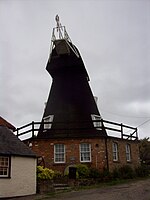Eastry railway station
1916 establishments in England1948 disestablishments in EnglandDisused railway stations in KentFormer East Kent Light Railway stationsPages with no open date in Infobox station ... and 3 more
Railway stations in Great Britain closed in 1948Railway stations in Great Britain opened in 1916Use British English from August 2015
Eastry railway station was a railway station on the East Kent Light Railway. It opened on 16 October 1916 and closed to passenger traffic after the last train on 30 October 1948. It was the station before the Richborough Branch diverged from the main line to Wingham. The station served the village of Eastry, it had a passing loop, but this had been converted to a siding in 1948. The track was removed in May 1954. There is no trace of the station today as the area has been landscaped into fields.
Excerpt from the Wikipedia article Eastry railway station (License: CC BY-SA 3.0, Authors).Eastry railway station
Gore Lane,
Geographical coordinates (GPS) Address External links Nearby Places Show on map
Geographical coordinates (GPS)
| Latitude | Longitude |
|---|---|
| N 51.2495 ° | E 1.3008 ° |
Address
Eastry
Gore Lane
CT13 0LQ , Eastry
England, United Kingdom
Open on Google Maps






